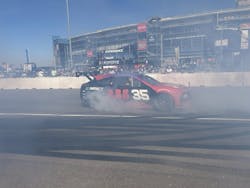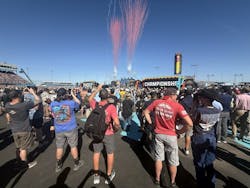Waving the Green Flag: Starting Electrification and Decarbonization with ABB and NASCAR
PHOENIX—If we’ve learned anything about capturing the attention and hearts of Americans, one of the coolest and fastest ways to get there is through the automobile.
Not just any car. The stunningly fast, sleek, unique and even sexy car.
The movie industry gets it. Think of “American Graffiti” or “Fast & Furious.” And if you’re trying to do this in the biggest event in the NASCAR racing season, it better be something that stands out and moves with style. The stock car world requires mojo of the front row kind.
Enter the ABB-NASCAR EV Prototype, built in partnership with Ford, Toyota and General Motors. And, although it debuted more than a year ago at the Chicago Street Race, this electric vehicle on steroids is still starting fast enough to draw thousands of eyeballs at last weekend’s NASCAR Championship Race at the Phoenix Raceway in Avondale, Arizona.
Much more than a smoke show
Billowing smoke from tires rubbing the asphalt via instantaneous electric motor power to the car, the EV prototype was applauded during pit stop competitions and tested again on the track on the Monday following Sunday’s title finale.
The main point is not simply raising the pulse of speed-loving NASCAR enthusiasts, although that helps. The destination of this journey is to start conversations about energy in the heart of America, according to ABB and NASCAR leaders engaged in the companies’ Electrification Innovation Partnership with each other.
This car is a way to get up close and personal with America,” Chris Shigas, ABB’s vice president of strategic partnerships and a key player in the NASCAR collaboration over the past several years.
“It’s all about having a better conversation about energy, really talking to fans,” Shigas added. “It’s teaching about the car but also teaching them about the larger energy picture in the United States. When fans come to see the car, they ask questions about how fast the car can go and that gets them the door asking what regenerative braking is and more.”
Steady, forward thinking keeps racing thrills rolling
Here comes the answer: the car is crazy fast but built with the understanding that EV adoption will be slow, deliberate and only a part of the overall energy transition. Transportation electrification is growing, but so are the fronts leading to decarbonization and energy efficiency in buildings. There are many paths to Net Zero.
And, of course, that’s the unsung part of this ABB-NASCAR partnership. Swiss-based ABB is helping the stock car racing giant find ways to reduce costs and emissions at its 16 owned racing tracks, as well as EV charging infrastructure at NASCAR’s Daytona headquarters and energy management projects within the research and development center in Concord, North Carolina.
Know this about NASCAR as a company: It is historically known for the roar of the engine, but its bottom-line mindset is clearly set on a future of responsible environmental, financial and energy efficiency.
“I believe we’ve taken leaps and bounds” in understanding energy management and decarbonization on the corporate level,” C.J. Tobin, director of vehicle systems at NASCAR R&D and a key engineering voice on the EV prototype, said. “ABB has helped us move that along even more than we thought possible. They came to our R&D facility, and there is a lot of energy delivered to our building. They helped us understand what we can do better.”
Today NASCAR and tomorrow the heartland of America. Bank on it.
Energy efficiency and electrification on the commercial, industrial and residential levels could save the U.S. trillions of dollars and millions of metric tons of greenhouse gas emissions, but it’s a hard road without public support. Spotlighting those issues, even if only for a fraction of the time during Championship Weekend, is fruitful when some 50,000-plus fans are basically living in Avondale for the three days of events.
“The idea is not to take away the old way, but the idea is through partnership with NASCAR on the energy impact to the heart of America,” Khalid Mandri, president of ABB’s global Electrification Installation Products Division.
“The energy transition is what it’s all about,” Mandri added, noting that phrase is not just about renewables but also about decarbonization on multiple fronts. “The U.S. grid is... pretty old...and it’s a D+ (in reference to the American Society of Civil Engineer’s recent scorecard). At ABB we want to bring it to a C, B and potentially an A.”
Innovating on equipment technology and tightening the electrification supply chain in the U.S. are priorities for ABB in its biggest market. As noted by Alex Richert, who is the company’s US/Latin America Region Leader for the Electrification Installation Products Division, ABB has invested more than $14 billion in manufacturing and distribution technology across its U.S. facilities.
“We pride ourselves on being sustainable, even in our own factories moving from gas boilers to electric boilers, to electric molding presses. That movement is under way,” Richert said.
Overengineering is good: Matching vehicle science to star power
And movement is what it’s all about at NASCAR Championship, whether it’s fans rushing to fist-bump their favorite driver, the late move made by Kyle Larson to win the title or the heads which turned to catch a glimpse or longer of actress Sydney Sweeney on stage during the race introductions.
But drivers and movie stars aside, it’s really about cars, technology and the future.
That’s what drives NASCAR’s Tobin up the most over the three years he’s spent in helping to engineer the EV prototype. Much of the body is shared by the Next-Gen racing model seen turning left high rates of speed on Saturdays and Sundays, but the battery innovation and sheer power or progress is surprising even those closest to the electrification project.
Read about ABB's work with Formula E racing
The idea is not only to engineer, but overengineer and see what limits can be exceeded.
“I’ve gotten a crash course in high voltage systems,” Tobin pointed out. “Other than the efficiency (of electric motor drives), when you look at our style of racing with stock cars (fuel management) is the same exact way with battery management.”
They are learning so much and are pumped to share the news.
“Instantaneous power to the vehicle,” Tobin said. “When our test driver, David Ragan, got out of the car, the first thing he said was ‘every driver should feel this.’”
Both NASCAR and ABB hope that heart of America feels it too and likes it. The future is inevitable in that greater technology always wins and favors those who embrace it. Nothing is different in the energy transition to follow where multiple resources are going to be needed.
“There’s a lot of false choice arguments out there,” ABB’s Shigas said. “Everything has to be all renewables, or everything has to be all fossil.”
The looming tide of greater demand from data centers, AI and electrification will require all hands at the wheel.
“What we do know is we need generation and it’s going to come from a lot of resources,” Shigas added. “Let’s start with the cleanest, and when it’s not available let’s switch to the next cleanest.
“What we’re learning is that EVs go more miles, not less, that charging times come down, not up. The technology gets better.”
And faster.
About the Author
Rod Walton, EnergyTech Managing Editor
Managing Editor
For EnergyTech editorial inquiries, please contact Managing Editor Rod Walton at [email protected].
Rod Walton has spent 17 years covering the energy industry as a newspaper and trade journalist. He formerly was energy writer and business editor at the Tulsa World. Later, he spent six years covering the electricity power sector for Pennwell and Clarion Events. He joined Endeavor and EnergyTech in November 2021.
Walton earned his Bachelors degree in journalism from the University of Oklahoma. His career stops include the Moore American, Bartlesville Examiner-Enterprise, Wagoner Tribune and Tulsa World.
EnergyTech is focused on the mission critical and large-scale energy users and their sustainability and resiliency goals. These include the commercial and industrial sectors, as well as the military, universities, data centers and microgrids. The C&I sectors together account for close to 30 percent of greenhouse gas emissions in the U.S.
He was named Managing Editor for Microgrid Knowledge and EnergyTech starting July 1, 2023
Many large-scale energy users such as Fortune 500 companies, and mission-critical users such as military bases, universities, healthcare facilities, public safety and data centers, shifting their energy priorities to reach net-zero carbon goals within the coming decades. These include plans for renewable energy power purchase agreements, but also on-site resiliency projects such as microgrids, combined heat and power, rooftop solar, energy storage, digitalization and building efficiency upgrades.



